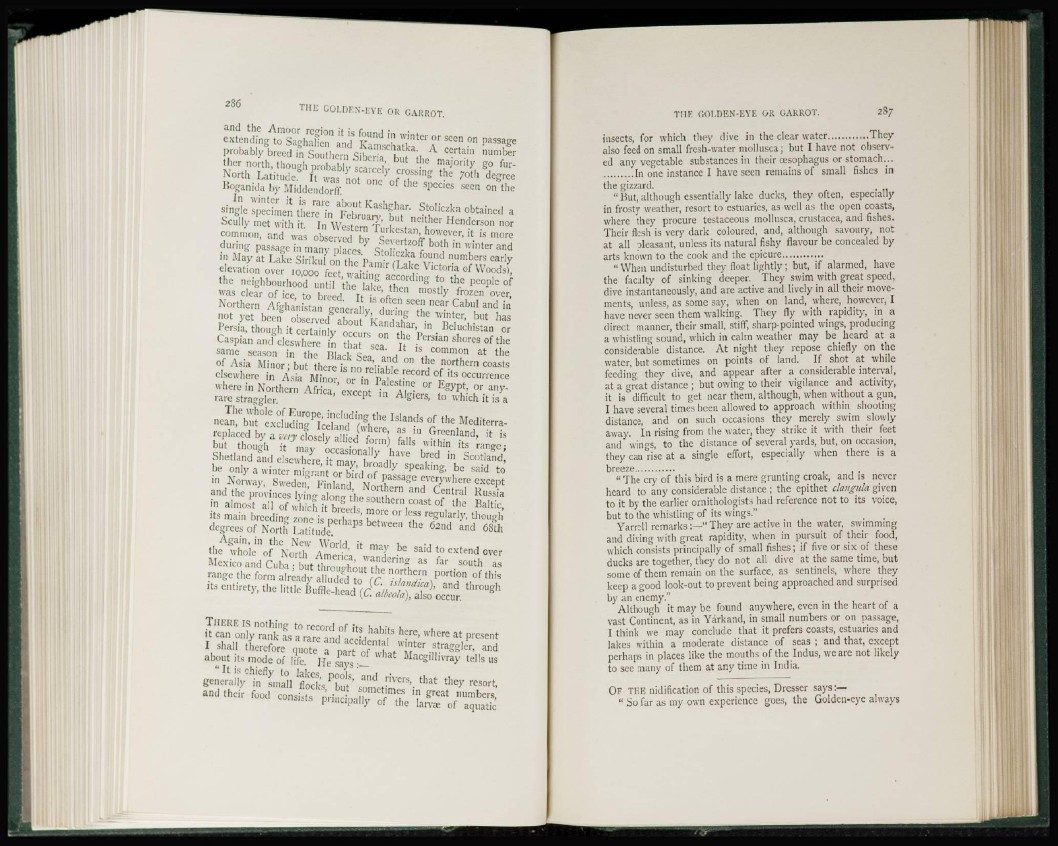
236
THE GOLDEN-EYE OR GARROT.
and the Amoor region it is found in winter or seen on passage
extending to Saghalien and Kamschatka, A certain number
probably breed in Southern Siberia, but the majority go further
north, though probably scarcely crossing the 70th degree
North Latitude. It was not one of the species seen on the
Bogamda by Midden dor ff
In winter it is rare about Kashghar. Stoliczka obtained a
single specimen there in February, but neither Henderson nor
Scully met with it. In Western Turkestan, however, it is more
common, and was observed by Severtzoff both in winter and
during passage in many places. Stoliczka found numbers early
in May at Lake Sirikul on the Pamir (Lake Victoria of Woods),
elevation over 1 0 , 0 0 0 feet, waiting according to the people of
the neighbourhood until the lake, then mostly frozen over,
was clear of ice, to breed. It is often seen near Cabul and in
Northern Afghanistan generally, during the winter, but has
not yet been observed about Kandahar, in Beluchistan or
Persia, though it certainly occurs on the Persian shores of the
Caspian and cleswherc in that sea. It is common at the
same season in the Black Sea, and on the northern coasts
of Asia Minor ; but there is no reliable record of its occurrence
elsewhere in Asia Minor, or in Palestine or Egypt, or anywhere
in Northern Africa, except in Algiers, to which it is a
rare straggler.
The whole of Europe, including the Islands of the Mediterranean,
but excluding Iceland (where, as in Greenland, it is
replaced by a very closely allied form) falls within its range;
but though it may occasionally have bred in Scotland,
Shetland and elsewhere, it may, broadly speaking, be said to
be only a winter migrant or bird of passage everywhere except
in Norway, Sweden, Finland, Northern and Central Russia
and the provinces lying along the southern coast of the Baltic,
in almost all of which it breeds, more or less regularly, though
its main breeding zone is perhaps between the 62nd and 68th
degrees of North Latitude.
Again, in the New World, it may be said to extend over
the whole of North America, wandering as far south as
Mexico and Cuba ; but throughout the northern portion of this
range the form already alluded to (C. isfandica), and through
its entirety, the little Buffle-hcad (C. aihcold), also occur.
THERE IS nothing to record n r 1 1 1
it can only rank Í a rare andl ¿el ^ w h e r e a t Pr e s e i 1 t
I shall therefore quote a >art of ? ,"'St e'' S t r a » 2 , e r - a n d
about its mode of life H e say 1 Macgillivray tells us
anchen food « ^ ^ ^ " S S
THE GOT,DEN-EYE OR GARROT. 23/
insects, for which they dive in the clear water They
also feed on small fresh-water inollusca; but I have not observed
any vegetable substances in their oesophagus or stomach...
In one instance I have seen remains of small fishes in
the gizzard.
" But, although essentially lake ducks, they often, especially
in frosty weather, resort to estuaries, as well as the open coasts,
where they procure testaceous mollusca, Crustacea, and fishes.
Their flesh is very dark coloured, and, although savoury, not
at all pleasant, unless its natural fishy flavour be concealed by
arts known to the cook and the epicure
" When undisturbed they float lightly ; but, if alarmed, have
the faculty of sinking deeper. They swim with great speed,
dive instantaneously, and are active and lively in all their movements,
unless, as some say, when on land, where, however, I
have never seen them walking. They fly with rapidity, in a
direct manner, their small, stiff, sharp-pointed wings, producing
a whistling sound, which in calm weather may be heard at a
considerable distance. At night they repose chiefly on the
water, but sometimes on points of land. If shot at while
feeding, they dive, and appear after a considerable interval,
at a great distance ; but owing to their vigilance and activity,
it is difficult to get near them, although, when without a gun,
I have several times been allowed to approach within shooting
distance, and on such occasions they merely swim slowly
away. In rising from the water, they strike it with their feet
and wings, to the distance of several yards, but, on occasion,
they cau rise at a single effort, especially when there is a
breeze
"The cry of this bird is a mere grunting croak, and is never
heard to any considerable distance ; the epithet clangula given
to it by the earlier ornithologists had reference not to its voice,
but to the whistling of its wings."
Yarrcll remarks :—" They arc active in the water, swimming
and diving with great rapidity, when in pursuit of their food,
which consists principally of small fishes; if five or six of these
ducks arc together, they do not all dive at the same time, but
some of them remain on the surface, as sentinels, where they
keep a good look-out to prevent being approached and surprised
by an enemy."
Although it may be found anywhere, even in the heart of a
vast Continent, as in Yarkand, in small numbers or on passage,
I think we may conclude that it prefers coasts, estuaries and
lakes within a moderate distance of seas ; and that, except
perhaps in places like the mouths of the Indus, we are not likely
to sec many of them at any time in India.
OF THE nidification of this species, Dresser says:—
" So far as my own experience goes, the Golden-eye always